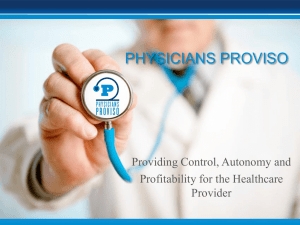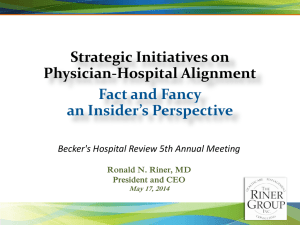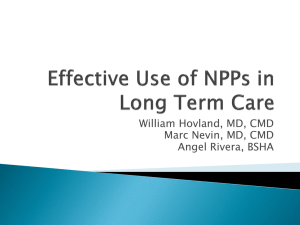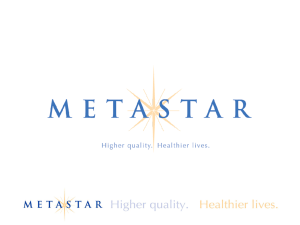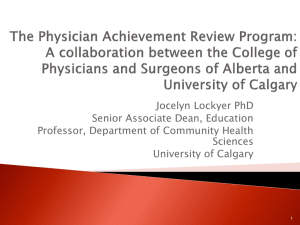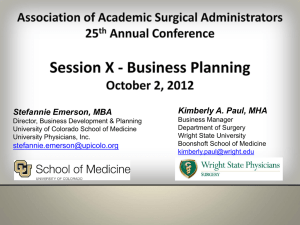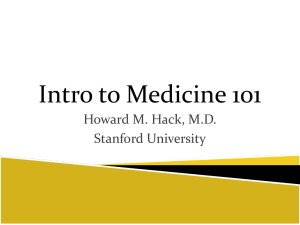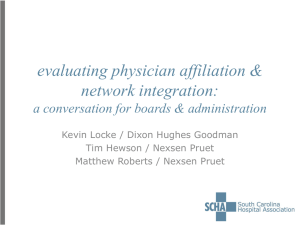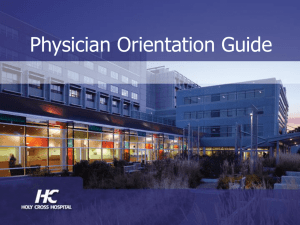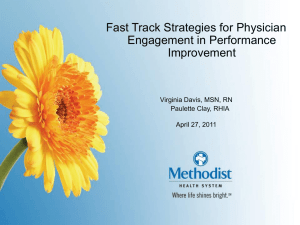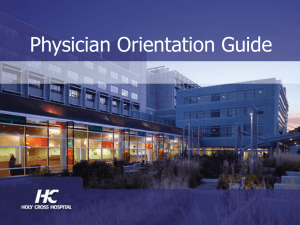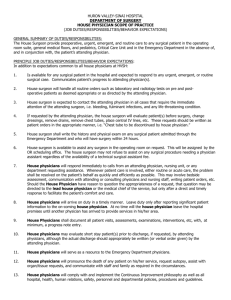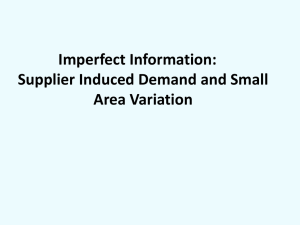婦產科也常被稱為
advertisement
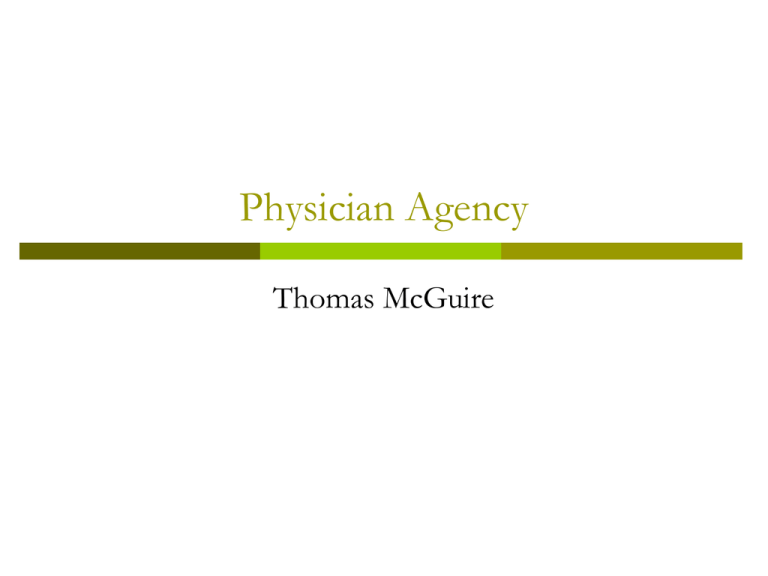
Physician Agency Thomas McGuire Questions Do physicians maximize profit? Are physicians constrained by market demand? Do physicians even set price and quantity? In what way do physician motives and power matter if insurance plans set price and quantity? This chapter will address motivation, market power, and price and quantity setting, referred to here collectively as the issue of “physician agency.” Physician incomes are very high, among the highest for any occupational group. In the 1970’s and 1980’s, physician earnings grew relative to college graduates and lawyers (Gaynor, 1994). In 1994, average physician net income, according to the AMA, was $182,400. Physicians average about 55 hours of work per week. Figuring 48 weeks per year, the average physician net wage was $65 per hour in 1994. Net is about half of gross. The average price charged by physicians in 1994 could be figured at approximately $130 for each hour of their time. 醫生薪資(1999) 醫生薪資(2011) Average range of salaries for physicians 2010. Specialty Anesthesiology Dermatology Emergency medicine Cardiac Surgery Family practice Internal medicine Neurology Obstetrics and Gynecology Ophthalmology Orthopedic surgery Median salary (USD) 331,000 to $423,507 313,100 to $480,088 239,000 to $316,296 218,684 to $500,000 175,000 to $220,196 184,200 to $231,691 213,000 to $301,327 251,500 to $326,924 150,000 to $351,000 397,879 to $600,000 Average range of salaries for physicians 2010. Specialty Otolaryngology Pathology Pediatrics Psychiatry Radiology (diagnostic) Surgery (general) Urology Neurological surgery Plastic surgery Gastroenterology Pulmonology Median salary (USD) 191,000 to $393,000 239,000 to $331,842 160,111 to $228,750 173,800 to $248,198 377,300 to $478,000 284,642 to $383,333 331,192 to $443,518 350,000 to $705,000 265,000 to $500,000 251,026 to $396,450 165,000 to $365,875 The number of physicians supplying health care is governed by licensing laws, including provisions for students trained outside the U.S., and the capacity of the 126 U.S. medical schools. About 16,000 students graduate from U.S. medical schools each year, and these are joined by 5,000 immigrant physicians. The accumulation of these flows has built the current stock of 550,000 physicians in active practice, a stock that is growing at about 1.5% per year. The AMA, from its founding in 1847, advocated uniform national licensure. Between 1880 and 1890, every state licensed medicine. With the reorganization and growth of the AMA between 1900 and 1910, and a rise in membership from 8,000 to 70,000 (Starr 1982, pp. 110, 112), membership began to be associated with hospital privileges and control of expert witnesses in malpractice cases. In his 1910 report, Medical Education in the U.S. and Canada, Flexner recommended an increase in the quality of medical education, uniform training (based on the Johns Hopkins model), and a decrease in the number of schools and students per school. 本土醫師養成 就讀醫學院醫學系 台灣醫學生需七年醫學教育 大二到大四修習基礎課程 大五、大六則是見習兩年 大七進入實習的階段 畢業國考才取得醫師執照,可獨立開業 住院醫師 住院醫師因不同的專科而有不同的年限 住院醫師訓練後經一年總住院醫師可考取專科醫師 98學年度大學考試分發(醫學系 ) 大學校名 國立臺灣大學 國立陽明大學 國立成功大學 長庚大學 臺北醫學大學 馬偕醫學院 高雄醫學大學 中國醫藥大學 輔仁大學 慈濟大學 中山醫學大學 學系名稱 科數 醫學系 6 醫學系 6 醫學系 6 醫學系 6 醫學系 6 醫學系 6 醫學系 6 醫學系 6 醫學系 6 醫學系 6 醫學系 6 最低分數 523.16 515.32 510.71 568.71 493.32 488.83 486.67 481.67 479.79 474.73 510.35 原始分數 523.16 515.32 510.71 505.52 493.32 488.83 486.67 481.67 479.79 474.73 471.09 醫學教育的成本很高,每年限制一千三百名醫學生的名額 可以確保投注的醫學教育成本能得到相當的回饋,進而導 致國考並不是要淘汰不適合的醫學生,而只是確保一個醫 學生有成為醫師應具備的基本能力。 國外修習 國外修習醫學課程的學生,根據醫師第四條之一的規定, 「以外國學歷參加考試者,其為美國、日本、歐洲、加拿 大、南非、澳洲、紐西蘭、新加坡及香港等地區或國家以 外之外國學歷,應先經教育部學歷甄試通過,始得參加考 試。」 除了九大區域外,到其他國家修習醫學課程都需通過學歷 甄試,才能再參加國家考試以取得醫師執照。 避免波波事件 成本標準化-各類人員年平均薪資(2003) 統計值 主治醫師每年平 住院醫師每年平 護理人員每年平 醫事人員每年平 行政人員每年平 均薪資 均薪資 均薪資 均薪資 均薪資 平均值 3,715,887 1,504,124 705,655 758,390 593,375 中位數 3,600,000 1,440,000 762,627 816,229 540,000 最小值 2,250,000 1,161,396 360,000 384,000 312,000 最大值 7,069,731 2,700,000 1,008,012 961,344 994,179 標準差 1379386.38 469741.31 205051.02 179041.09 227925.37 99年─受僱員工人數、平均每人月薪資—按職類別分 職 類 別 總計 受 僱 員 工 人 數 總 薪 資 經 常 性 薪 資 非 經 常 性 薪 資 6,676,119 41,571 36,207 5,364 630,464 56,348 48,784 7,564 地質工程師 54 78,742 78,438 304 精算師 77 150,724 146,497 4,227 系統分析師 32,284 60,168 51,830 8,338 程式設計師 39,164 52,677 47,536 5,141 電腦維護工程師 33,691 42,219 39,388 2,831 航空機械工程師 643 59,249 57,447 1,802 冶金、採礦、鑽探工程 310 205,378 65,017 140,361 2,397 41,329 38,465 2,864 醫師 44,260 119,298 104,598 14,700 藥劑師 22,706 44,859 41,926 2,933 144,869 40,060 37,656 2,404 2,848 62,644 52,394 10,250 648 112,047 81,566 30,481 4,266 80,957 66,050 14,907 專業人員 生物科學工程師 護理人員 會計師 律師 財金及經濟分析研究 行政院勞工委員會「職類別薪資調查報告」顯示,99年7 月各行業不含自行開業之「受僱醫師」平均薪資約119,298 元 薪資水準最高10%的醫師,僅每月平均經常性薪資已達 175,600元之譜,再加計績效獎金、年終獎金及其他津貼, 每月薪資數十萬元不足為奇。 全民健保開辦之後,醫院及診所的經營費用大多來自健保 給付或醫療保險給付,醫師與牙醫師的薪資很大一部分是 看服務的病人數,這部分會影響到紅利、點數、業績等, 而點值也跟專業科別有關,例如外科點值較高、復健科比 較低,因此薪資水準的差異很大,通常風險較高、自費項 目多的科別,或是技術性高、專業性強的醫師薪資會較高。 急診醫生荒 喊40萬月薪找不到人? 台灣的醫師荒日益嚴重,不僅內外婦兒「四大皆空」,近 來急診科醫師也人力告急。由於急診醫師發生醫療糾紛風 險高,部分區域醫院、地區醫院越來越不容易招募到急診 主治醫師,不少醫院紛紛開出近40萬元的月薪招人。和不 必值班的新進醫師月薪約10萬元相比,條件實在優渥,各 醫院都希望以高薪待遇爭取年輕新血。 壢新醫院:「具急診專科醫師證書39萬元起、亦歡迎內外兒 科,薪資面議」 台大醫院新竹分院: 月薪35萬元 童綜合醫院: 院內較資淺的急診醫師月薪約38萬元 醫療糾紛判賠3千萬 曾收治“人球案”邱小妹童綜合醫院神經外科醫師李明 鐘,因車禍病患醫療糾紛,日前被台中高分院宣判,醫院 與李明鐘等三名醫師,要連帶賠償3000多萬元(新台幣, 下同)。此判決引發神經外科醫學會高度反彈,今將召開 記者會聲援李明鐘。 台中市民陳仁傑七年前發生車禍頭部受重創,經醫師手術 後全身癱瘓、雙眼全盲,家屬請求損害賠償,一審判決童 綜合醫院及三名醫師賠償2800余萬,兩造不服均提起上 訴,二審查出醫師未在手術後放置腦壓監測器,致陳全身 癱瘓,判決醫院及三名醫師賠償3200多萬元。 醫療糾紛判賠3千萬 2005年九月間,陳仁傑車禍送童綜合醫院,經電腦斷層檢 查,發現顱內出血,由主治醫師李明鐘做硬腦膜外血腫清 除術後,再由醫師呂志明、李傳輝照顧,三天內,昏迷指 數從恢復八分,又下降至五分,家屬見狀轉院,昏迷指數 降至三分。 陳仁傑家人不滿童綜合醫院、李明鐘等三名醫師疏失,致 陳腦部右側出血量,擠壓至左側,腦部持續累積血塊,造 成二度腦創傷,致其腦部細胞壞死而左側癱瘓,雙目失 明。 經陳父陳福德提起損害賠償,一審法官認為,醫師未積極 追蹤腦壓變化,直到他陷入昏迷還有血塊未清,導致陳成 為植物人,認定醫院及醫師有過失,判賠兩千八百餘萬 元。 醫療糾紛判賠3千萬 台灣神經外科醫學會表示,置放顱內壓監測器,有相當高風險, 可能造成感染、出血、堵塞,甚至傷害腦組織,所以進行置放 手術前,需慎重其事,醫師應對患者及家屬詳細解說,才能做 最適當處置。 內外婦兒,四大皆空 監察委員黃煌雄於日前(4/14)在第三波全民健康保險改 革研討會前會中,發表半年來走訪醫院、醫師訪談結果, 發現健保醫療資源錯置,未來應積極檢討健保支出及資源 分配問題,也應重振內外婦兒4大科,並呼籲改革健保支 出。黃委員的發言,再度點出內外婦兒四科「四大皆空」 的陳年老問題。為此,立委涂醒哲於今日(4/22)召開 「內外婦兒,四大皆空,醫療生態危機」公聽會,邀請官 方代表、中華民國醫師公會全國聯合會、台灣醫學會、內 外婦兒四科醫學會代表,並探討內外婦兒等科,為何人力 不足?醫療糾紛及給付制度產生哪些問題?醫療生態的破 壞對民眾健康的衝擊,及改善之道為何? 內科 台灣醫學會及內科醫學會楊培銘秘書長則表示,內科人力 不足的問題,相較其他三科來說是較小的,但是人力不足 的問題仍會影響醫療品質及醫病關係,這部分仍值得政府 加以注意。內科目前存在的主要問題在於,因為給付制度 的不同而影響到醫師走向,使得內科內的不同科間也常在 作變換。 外科 台灣外科醫學會第一副秘書長林家瑋則認為,如何讓次專 科醫師的人數作合理分佈,是健保局的職責,而給付制度 需作修正及將資源作重分配;至於是否開放部分負擔,讓 病人願意補差價,這是值得思考的課題。對於醫療糾紛問 題,林則認為不應任由病人提出刑事告訴,否則易破壞醫 病關係及打擊醫師士氣。 婦產科 台灣婦產科醫學會黃閔照秘書長則語重心長的表示,婦產 科人力只占全國各科醫師人力6.8%,人力真的很吃緊,婦 產科醫師老化的問題也嚴重,需思考人力上的重新配置; 此外,婦產科也常被稱為「作愈多賠愈多的科」,若加上 開刀及醫療糾紛成本,則現行的給付制度對婦產科相當不 公平,久而久之也消磨掉婦產科醫師的熱情。黃閔照接著 說,在現行健保制度下,醫師常被稱為「廉價勞工」,醫 師無尊嚴,外界更常把醫師塑造成是愛錢的,這樣其實是 傷害醫病關係。 兒科 四大科最後發言的台灣兒科醫學會李秉穎秘書長表示,兒 科常被視為是「賠錢科」,也是醫院愈不想投資的科。少 子化不是問題,問題出在健保給付不公,政府常常只考量 到量,卻不考慮質的問題,而兒科在治療過程中,常常需 要用到許多設備,這部分卻得不到評鑑,最終影響到給 付。李秘書長並認為,預防醫學作的若愈成功,科別就會 愈萎縮,而這不應是國家未來的發展方向。對於醫療糾紛 的問題,李認為醫療院所應先過濾投訴信件,才能糾正不 當的醫療生態。最後,李建議醫師若不能入勞基法,至少 也應針對醫師制訂特別法,以保障醫師的權益。 「歷年專科醫師核證人數」 資料來源:行政院衛生署統計室 年度 89 90 91 92 93 94 95 96 97 98 99 內科 239 293 328 351 320 310 273 262 277 320 315 外科 169 131 157 186 178 171 158 159 149 126 138 婦科 62 62 50 67 54 55 39 42 36 29 33 兒科 149 184 209 209 144 132 117 117 123 96 94 Do physicians maximize profit? Are physicians constrained by market demand? Do physicians even set price and quantity? In what way do physician motives and power matter if insurance plans set price and quantity? 市場均衡 P 價格 A’ A E B B’ X 數量 市場均衡 供給曲線(生產者) 需求曲線(消費者) 均衡數量 均衡價格 生產者和消費者 生產者 醫院 醫師 護理人員 消費者 病患 均衡數量和價格 均衡數量 就診次數(門診) 就診次數(住院) 就診天數(住院) 均衡價格 單次費用(門診) 每天費用(住診) 市場均衡假設 許多生產者 許多消費者 市場資訊會流通 消費者相互比價 生產者相互比價 買賣品質有保障 →彼此在品質和價格上相互競爭 醫療市場特性 市場資訊不流通 消費者不比價 生產者不比價 買賣品質沒保障 醫療保險 市場資訊不流通 消費者不比價 生產者不比價 買賣品質沒保障 Setting 1: both q and p are controls The quantity x is optimal since b(x)=c The physician sets the price to extract the CS up to NB0 Setting 2: with insurance, q as the control The quantity x is more than the optimal since θp > b(x) (as long as p > c) The physician chooses x to extract the CS up to NB0 If p goes down, x would go up (dx/dp<0) Setting 3: with insurance, q and e as controls Payment scheme: R+Psx (R>0, c>Ps>0) NB = B(x, e)-Pd x Bx>0 Bxx<0, Be>0 Bee<0 C(e)>0 ce>0 cee>0 Setting 3: with insurance, q and e as controls R=0, Bx - Pd <0 Setting 4: physician induced demand PID exists when the physician influences a patient’s demand to care against the physician interpretation of the best interest of the patient (Fuchs, 1978) Influence v.s. Inducement Undue influence Utilization v.s. Demand Changing utilization may not change demand There are other ways to change demands (ration, efforts, etc) Physicians can alter the patient’s preferences It has many direct policy implications Training fewer surgeons will reduce the unnecessary surgery To make physician fee policy within a budget constraint, it must be anticipated that fee reduction induces quantity increases Setting 4: physician induced demand Theory of Demand Inducement N↓ → income effect →Uy/ Ui ↓ → i1, i2 ↑ m1 ↓ → income +substitution → i1 ? m1 ↓ → income → i2 ↑

